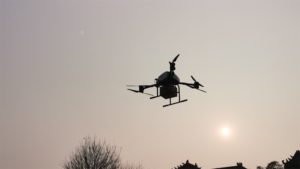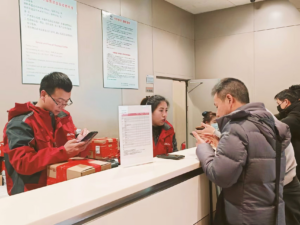Feb 26, 2020|
In-depth Report: Drones & Robots: Deploying New Technology to Handle Crisis
by Tracy Yang
While e-commerce giants, logistics companies and technology icons are drawing the battle lines to gain the approval from the US government on commercial application of autonomous devices for last-mile delivery, China is already ahead of the game. This is true for applying drones and autonomous delivery robots into daily operations, and can even be seen in waging the war against COVID-19.
As China’s largest retailer, JD.com has arguably won the hearts of Chinese consumers who know the company because of its commitment to authenticity and fast delivery. The outbreak of SARS 17 years ago led to the development of China’s e-commerce industry, among which JD took its business online and developed industry leadership since. JD has always put customers first, which drove the decision to invest significantly in building up its own logistics network more than 10 years ago.
Not many people were as forward-looking as JD’s management team, especially its founder Richard Liu, was at that time. However, JD Logistics has successfully transformed from being a cost center to a profit center. Currently, JD boasts a nationwide logistics network in China and provides the same and next day delivery service to Chinese consumers as a standard service, which no other e-commerce company in the world can possibly match.
JD is always looking to the future and continues to explore the next generation of logistics, and has leveraged its technology innovation to make drone and autonomous delivery robots be applicable for commercial use. The technologies are quite mature, although the application is not yet available at a large scale.
Drones to the Rescue – in the Air
JD started to use innovative drone technology to reach consumers in some of China’s hard-to-reach remote areas during the Singles Day (November 11th ) sales festival in 2016. The service was available in four rural locations including the outskirts of Beijing and the provinces of Jiangsu, Shaanxi, and Sichuan. JD understood it was the first e-commerce company in the world to put drone technology into this kind of commercial use.
The drone infrastructure was developed by JD X, JD’s research and logistics innovation lab, which is focused on developing smart logistics solutions to make the passage of goods from warehouses to Chinese customers ever quicker, cheaper and more efficient.
Although JD’s fast delivery is impressive to Chinese consumers, in the more remote areas where the terrain is complex and infrastructure is poor, last-mile logistics can be challenging. This can make the overall online shopping experience more difficult and less satisfying.
The JD Drone program was born to address this challenge. It has been designed as a cost-effective, scalable, safe and reliable way to bring new opportunities to remote rural communities in China that are currently underserved by the e-commerce industry. The program works by dispatching orders from regional delivery stations to the entrance of the village. Local partners will then distribute the orders directly to customers.
JD drones have been used in emergency relief efforts for several years. In July 2018, the company deployed a team of drone engineers as well as drones and ancillary vehicles to support the Beijing municipal government’s storm relief efforts, which was JD’s first disaster relief effort using drones following its establishment of China’s first nationwide drone rescue team two months earlier.
JD drones have played an important role in supporting the fight against COVID-19, including delivering the daily necessities to Chinese consumers as well as assisting several major cities in China to provide protective measures when more people return to work after the Chinese New Year holiday.
Dongyuan Xincun, a community in Dalad Banner county in Inner Mongolia, was deeply impacted by COVID-19 and closed from Jan 28th to Feb 19th. There are 36 buildings in this community and around 800 families who had to stay at home to avoid cross-infection. Two days before the community was open, JD’s drones helped them to disinfect the community, which is both a safer and more efficient approach. No human labor was needed, and it significantly reduced the risk of cross-infection. The drone can carry disinfectant weighing 10kg and flies within a radius of 5 kilometers.

JD drone abilities in spraying disinfectant successfully relies on previous experience in plant protection programs, which require drones to fly fairly low and spray pesticides. When spraying the disinfectant, atomization will be less but the spray will have wide cover.
Hang Ba, the Head of JD’s Drone Program said, “In terms of technology development and scenario application, JD drone is taking the leading position when exploring the possibilities of putting drones into commercial use. In addition to the daily operation in the rural areas in China, we will focus on empowering other partners with our technology capabilities and helping them address the challenge of higher cost in manpower in the logistics industry.”
Autonomous Delivery Robots Meeting Needs – on the Ground
It was a dark evening in Wuhan on February 6th. The street was quite empty, and there was almost nobody out, which is the normal state of affairs in this city since the outbreak of COVID-19. JD’s autonomous delivery robot was seen moving from JD’s Renhe delivery station to Wuhan Ninth Hospital, which is the designated hospital for the treatment of patients suffering novel coronavirus pneumonia in Wuhan. After less than five minutes, some daily necessities were delivered to the hospital, which previously were hand deliveries, delivered by JD Logistics couriers.
Jianbin Zhou is a courier from JD Logistics, who has been working during the Chinese New Year holiday and the epidemic period. He said, “Currently JD.com has sent over the autonomous delivery robots to Wuhan, which could help with the delivery to the hospitals and communities in Wuhan. It can better protect the couriers and the consumers.”
Due to the support from engineers in the JD X department under JD Logistics and through the processes of collecting the data for mapping, running tests from cloud, updating the hardware and software of the autonomous delivery robots as well as training the couriers, it took around five days to complete the first order through JD’s autonomous delivery robot in Wuhan. In fact, JD’s autonomous delivery robots started to be involved in daily operations in January 2019, which laid the solid foundation for the quick deployment in Wuhan in such a limited time.
At present, there are two daily routes for JD’s autonomous delivery robots in Wuhan. One is from Renhe station to the Ninth hospital, which also reaches a community in between. The other route is the delivery to two communities in Wuhan. Currently around 50% of the orders in these two daily routes can be delivered by JD’s autonomous delivery robots.
Featuring high reliability and stability, JD’s latest autonomous delivery robots can deal with bad weather, night driving and other conditions. They are also equipped with a simulation system, which can stimulate real road conditions to test the robots in real scenarios. Engineers can update the algorithm quickly based on the test results and keep optimizing the system as needed.
Qi Kong, Head of Autonomous Driving at JD Logistics said, “JD.com has taken a leading position in putting autonomous delivery robots in real scenarios, and our support to Wuhan is a great example. During the epidemic period, when it’s recommended to maintain no human contact, the two daily operation routes in Wuhan is accelerating the process for local consumers to adopt the new technology.”
JD has launched two smart delivery stations in the cities of Changsha and Hohhot, strengthening the e-commerce giant’s autonomous logistics capabilities in early 2019.
The stations are carrying out R&D, testing and personnel training to solve issues related to last mile delivery. JD’s delivery robots can be loaded with up to 30 parcels before autonomously delivering them to a site within a 5-kilometer radius. The vehicles can plan routes, avoid obstacles and recognize traffic lights. Running at full capacity, the delivery stations, operating with a half-half split between robots and couriers, can deliver up to 2,000 packages a day.
Due to the outbreak of COVID-19 in China, these “contactless” logistics solutions have attracted public interest. Drones and autonomous delivery robots can not only drive results without the risk of human contact but also help enterprises improve efficiency and reduce cost. But, it can only do so when the applications are available at scale. There is no clear outlook for when autonomous technologies will be available as such. There are still challenges ahead, like clear industry standards and policies, the stability of high-speed networks, battery charging solutions and so on. However, the outbreak of COVID-19 indeed puts these technologies under the spotlight and is causing enterprises to rethink how much they should invest to further develop these technologies.
People here at JD.com believe that drones and robots will have a huge market tomorrow. Tomorrow will come for sure.
(tracy.yang@jd.com)





 This Harbin tourism boom has also spurred a surge in sales of winter apparel. JD.com’s data indicates a rapid growth in the sales of warm clothing items such as down jackets, snow boots, and thermal underwear between January 1st and 7th. The sales growth is especially pronounced in southern provinces and cities such as Jiangsu, Zhejiang, Guangdong, Sichuan, and Shanghai. Notably, tall snow boots registered a 206% year-on-year increase in transactions, while padded cotton caps and thickened long down jackets soared by 158% and 134%, respectively. Beyond clothing, travel gear has also seen a considerable uptick, with a 98% year-on-year growth in transactions for large suitcases and travel backpacks in these southern regions.
This Harbin tourism boom has also spurred a surge in sales of winter apparel. JD.com’s data indicates a rapid growth in the sales of warm clothing items such as down jackets, snow boots, and thermal underwear between January 1st and 7th. The sales growth is especially pronounced in southern provinces and cities such as Jiangsu, Zhejiang, Guangdong, Sichuan, and Shanghai. Notably, tall snow boots registered a 206% year-on-year increase in transactions, while padded cotton caps and thickened long down jackets soared by 158% and 134%, respectively. Beyond clothing, travel gear has also seen a considerable uptick, with a 98% year-on-year growth in transactions for large suitcases and travel backpacks in these southern regions. In-depth Report: How JD Tackles Counterfeits
In-depth Report: How JD Tackles Counterfeits



